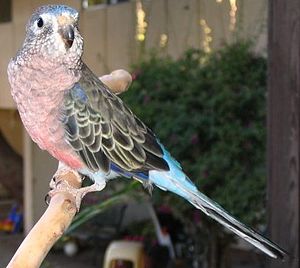Bourke's Parakeet
| Bourke's Parakeet | ||||||||||||
|---|---|---|---|---|---|---|---|---|---|---|---|---|

Bourke's Parakeet ( Neopsephotus bourkii ) |
||||||||||||
| Systematics | ||||||||||||
|
||||||||||||
| Scientific name | ||||||||||||
| Neopsephotus bourkii | ||||||||||||
| ( Gould , 1841) |
The Bourke Parakeet or Rose- bellied Parakeet ( Neopsephotus bourkii ) is a species of bird from the order of the parrots (Psittaciformes). Its natural habitat is the inner part of Australia . It grows to around 19 to 22 centimeters and weighs 30 to 50 grams. It was discovered in 1835 by Sir Thomas L. Mitchell , and John Gould first described it in 1841. It was named after General Sir Richard Bourke , who served as Governor of New South Wales from 1831 to 1837 .
The Bourke's Parakeet was previously assigned to the genus Neophema ( grass parakeets ), but was then reclassified into its own genus Neopsephotus , which currently includes only one species, N. bourkii .
Appearance and build
Bourke's Parakeets grow to be about 19 to 22 centimeters tall and weigh about 30 to 50 grams. Male animals are red-brown on the upper side and pink to brownish on the chest and belly. The forehead, shoulders, wings and tail feathers are blue to gray in color. The coloring of the females is usually less intense than that of the males. In addition, they lack the blue color on their foreheads. The head and beak are usually smaller in females than in males. Young birds resemble the females in their coloring. The eyes are comparatively large in terms of body size.
Distribution and way of life
The ancestral habitat of the Bourke's Parakeets is the dry, acacia- covered steppe shrub in inland Australia. Bourke's Parakeets mostly stay on the ground because their diet consists mainly of plant seeds and grass.
Bourke's Parakeets live in pairs or in groups of around 20 to 30 animals, but sometimes in larger flocks of up to around 100 birds in the dry season. The animals are crepuscular, so they prefer to be active in the early morning or evening. They live nomadically and mainly follow the food supply.
They are cave breeders, their breeding season is between August and December. The clutch, which consists of three to six eggs on average, is incubated by the female alone. The male takes over the feeding of the female. The breeding period averages 18 days. The young animals are able to fly after about four weeks and independent after another one to two weeks.
Life expectancy is around ten to twelve years.
Keeping as pets
The first living specimens came to Europe in 1867 and were shown at London Zoo . The first breeding successes came ten years later in Belgium, in 1880 in Germany and in 1906 for the first time in England.
Bourke's parakeets are comparatively easy to keep as pets, but not as popular as budgies or cockatiels, for example . They were and are mistakenly mistaken for red budgies or sold as such, partly because of their similarity in physique. There have also been unsuccessful attempts to breed red budgies by crossing them with Bourke's parakeets.
Housing, feeding and other keeping conditions are essentially the same as for budgerigars or cockatiels. Bourke's parakeets generally get along well with these species, so that socialization is hardly a problem if there is enough space. When staying in the apartment and thus in contact with people, your twilight activity as well as your preference for being on the ground and the associated dangers must be taken into account.
literature
- Horst Bielfeld : Grass Parakeets. Neophema and Neopsephotus. 2nd Edition. Verlag Eugen Ulmer , Stuttgart 1999, ISBN 3-8001-7465-0 .
- Joseph M. Forshaw : Australian Parrots. 1st German-language edition. Volume 2, Arndt-Verlag , Bretten 2003, ISBN 3-9808245-2-7 .
Web links
- Neopsephotus bourkii in the Red List of Threatened Species of the IUCN 2008. Posted by: BirdLife International, 2008. Accessed on December 18 of 2008.
- Videos, photos and sound recordings for Neopsephotus bourkii in the Internet Bird Collection

